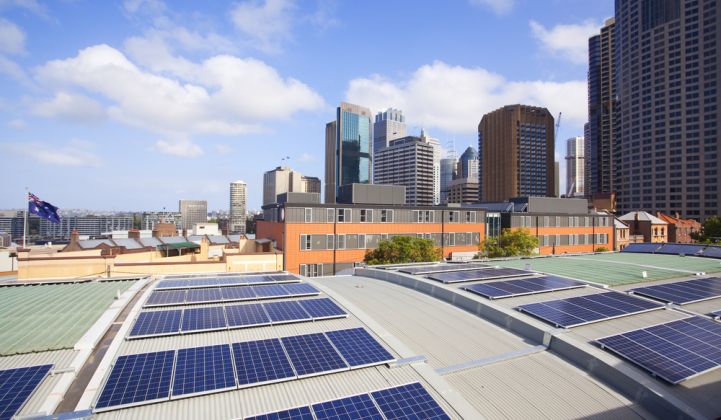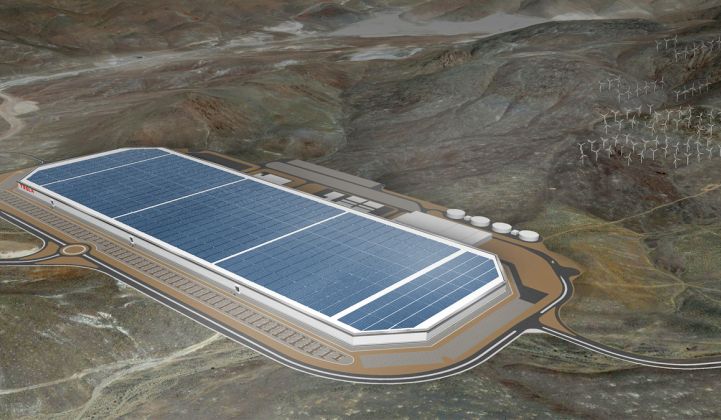Target took the top spot for corporate solar procurement last year; it now has rooftop solar on 436 store locations. Amazon, meanwhile, has deployed 17 rooftop solar systems in just the past 14 months.
On-site rooftop solar is within grasp for an increasing number of U.S. businesses — and not just the Targets and Amazons of the world.
The commercial and industrial solar market saw more than 2 gigawatts of new installations in 2017, and GTM Research indicates the market for commercial solar will grow at an average annual rate of 9 percent through 2022.

Nearly half of all Fortune 500 companies have renewable energy targets. But beyond the largest corporations, the market remains highly fragmented and the long tail of commercial solar is still largely untapped as financiers, project owners, installers and suppliers continue to face significant hurdles.
Evolving solar technology tailored to C&I
There are challenges in deploying C&I solar. Regulatory policy shifts are underway in leading states like California, Massachusetts and New York, and some projects in up-and-coming solar states may no longer pencil out economically due to Section 201 tariffs being imposed on imported crystalline silicon solar cells and modules.
But there are some positive shifts, too, including a new lower corporate tax rate that could increase the return for commercial solar. Financing options have also improved somewhat for small and medium-sized commercial projects, although there is still vast room for improvement.
The increasing role of string inverters may alleviate some of the burden on getting commercial projects done. Inverter prices are falling overall. GTM Research’s most recent global inverter report forecasts steep declines will continue across all inverter market segments, with 10 to 15 percent annual declines through this year and with continuing but more modest declines in 2019. The shift toward string inverters also offers benefits in terms of lifetime maintenance expenses and compliance with rapid shutdown requirements.
“What we have seen from certain customers is they are looking into savings on their overall costs, or they want to optimize the whole system or project,” said Richard Baldinger, head of marketing and customer experiences for inverter manufacturer Fronius USA, which does about half of its solar business in the C&I sector. “This is where a string inverter system that can adapt to the specific needs of a certain project can provide a big benefit, because a lot of systems out there are overcapitalized with equipment that is more expensive and has more components.”
A 24-kilowatt, three-phase string inverter with a shade cover and MC4 cabling options gives designers flexibility to forgo a rapid shutdown box, since Fronius’ latest inverter can be positioned within a rooftop array and serve double duty as a rapid shutdown switch. That takes away compliance headaches for NEC 2017 requirements, which are set to take effect in 2020.
Maximizing the space you have
String inverters can provide an operational advantage, because designs employing string inverters can maximize power density on a rooftop where space is at a premium, as well as protect against shading losses, said Fronius USA Commercial Product Manager Bret Young.
“Having more modules on a roof, independent of the size of a roof, its shape or obstructions, allows us to produce more energy early on,” said Young. “We end up being cash-positive sooner and at a higher margin.”
Even with cheaper inverters, project designers and owners still face significant obstacles on tight commercial rooftops. HVAC equipment and irregular roof shapes make a bit of a puzzle out of accessibility requirements for fire and O&M. String-based design schemes can be tailored so that inverters are placed on access pathways, better facilitating O&M access, compliance with fire and electrical codes, and optimum power density.
There are also less encumbered rooftop projects to pursue, Young said, like those over buildings used as holding facilities in the agriculture industry — buildings that, unlike big-box retail stores, don’t require an array of HVAC components, for example.
Given the complexity of the commercial market, there is an increasing need for solutions — both hardware and financing — that can be tailored to serve this diverse sector.
“Equipment manufacturers, financiers and installers need to make it easy for the myriad commercial businesses that want to have onsite solar,” said Baldinger. “As no roof and no business are the same, adaptability of solutions is key to offer tailored solutions that satisfy a specific customer’s needs.”

Text and pictures come from the web
Copyright to original author all rights reserved



